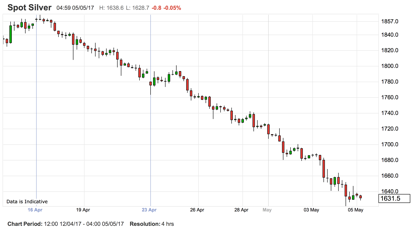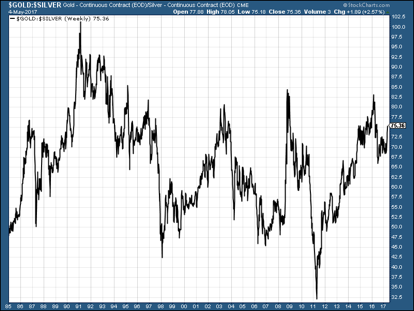Are we near a turning point in silver’s relentless decline?
The silver price has been in steady decline for some time. But for Dominic Frisby, the investment case remains compelling. Here, he explains why there’s still hope for silver investors.


Every cloud has a silver lining, runs the old saying. There is an exception to this, however, and that is silver itself. Every ounce of silver has a cloudy lining.
Don't own any silver and you are doomed to watch it rise. Own it, however, and you are doomed to watch it sink.
There is no metal more frustrating than silver. Bi-polar silver. The metal that doesn't know if it's base or precious.
MoneyWeek
Subscribe to MoneyWeek today and get your first six magazine issues absolutely FREE

Sign up to Money Morning
Don't miss the latest investment and personal finances news, market analysis, plus money-saving tips with our free twice-daily newsletter
Don't miss the latest investment and personal finances news, market analysis, plus money-saving tips with our free twice-daily newsletter
And silver is what we are considering this morning.
Avert your eyes this is one ugly chart

One likes one's charts to be rising from bottom left to top right. Silver has it the wrong way around.
Its current price is $16.30 an ounce, having been as high as $18.57 just a fortnight or so ago. In 2011 it hit $50, of course. In 2001 you could pay just $4 and get an ounce of the stuff.
The investment case for silver remains as utterly compelling as it has always been. The number of uses for silver keeps on growing, as the world gets more electronic. In other words, demand can only increase.
Meanwhile, new silver discoveries are as rare as a year in the UK when there isn't some kind of national vote. In other words, supply seems permanently on the verge of drying up.
And yet it never does.
As soon as you start looking at historical charts of silver in particular the ratios between the price of silver and other assets your mind starts thinking in terms of some kind of historical reversion to the mean. This would entail silver rising to $50, $100, or $200 an ounce.
In 1980, for example, at one point you could buy the average UK house (currently over £200,000) for about 1,000 ounces of silver (currently $16,300). In other words, silver would have to rise 15-fold to something over $200 for that particular ratio to be achieved again.
It's happened before, so it's not impossible, but it's unlikely.
Look at silver as a precious metal, and all the arguments that there are for owning gold apply, only more so. It is an asset outside of the financial system. It is nobody else's liability. All of this debt is going to lead to some kind of currency crisis. Monetary metals are going to go to the moon. If gold goes up 10%, silver will go up 30%. You get so much more leverage.
And so on.
Look at silver as a base metal, and the arguments for owning it remain manifold. Uses for silver keep on increasing, whether in electronics or in medicine, in batteries or in jewellery. If you're bullish on tech, own silver. If you're bullish on the rise of the new Asian middle class, own silver.
The investment story of silver is like something out of an Ancient Greek myth. It is doomed to be compelling, alluring, irresistible and beautiful. It is doomed to entrap you with its vast potential. Yet, once trapped, you are doomed to disappointment by its never-ending failure to deliver.
However, having properly put the boot in, I have some good news of sorts for you.
A glimmer of hope
Typically, and especially so over the last 20 years, when that ratio goes above 80 in other words when an ounce of gold is 80 times as expensive as an ounce of silver that has marked a "buy" point for silver.

Gold is currently 75 times the price of silver, so there is still some way to go before we hit that target. But the current price action is such that it wouldn't surprise me if that target were to be reached over the next few weeks. Perhaps we'll see gold at $1,200 and silver at $15, for example. (That is just me guessing, by the way. Please don't take those numbers too literally.)
I made this same point last year when the ratio between the two metals was at a similar level, and silver went on to enjoy a nice run. Like all things silver, it was doomed to disappoint. Instead of going back to the 50 area, when the ratio got to about 66, it turned and went back up again to where we are today.
But when the ratio hits 80, the trade is to sell gold and buy silver. When it goes below 50, it's usually time to start thinking about the reverse trade buying gold and selling silver.
And that ratio will go below 50 once again. But you can expect plenty of frustration and disappointment before it does so.
Get the latest financial news, insights and expert analysis from our award-winning MoneyWeek team, to help you understand what really matters when it comes to your finances.
Dominic Frisby (“mercurially witty” – the Spectator) is as far as we know the world’s only financial writer and comedian. He is the author of the popular newsletter the Flying Frisby and is MoneyWeek’s main commentator on gold, commodities, currencies and cryptocurrencies. He has also taken several of his shows to the Edinburgh Festival Fringe.
His books are Daylight Robbery - How Tax Changed our Past and Will Shape our Future; Bitcoin: the Future of Money? and Life After the State - Why We Don't Need Government.
Dominic was educated at St Paul's School, Manchester University and the Webber-Douglas Academy Of Dramatic Art.
You can follow him on X @dominicfrisby
-
 Why UK investors are backing British stocks in 2026
Why UK investors are backing British stocks in 2026The UK stock market may be lacking fashionable technology shares but investors are keen to buy British next year
-
 UK inflation live: did inflation fall in November?
UK inflation live: did inflation fall in November?The ONS releases inflation data for November tomorrow (17 December). Has inflation continued its downward trend?
